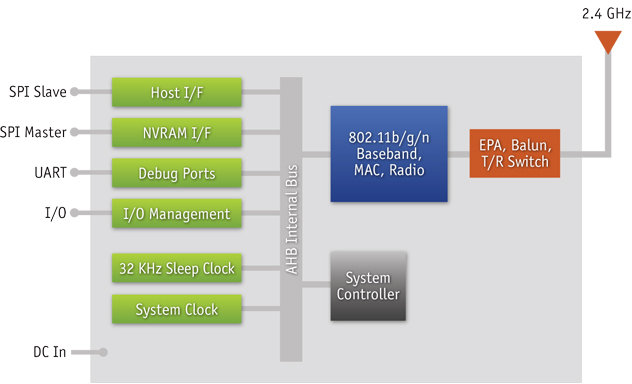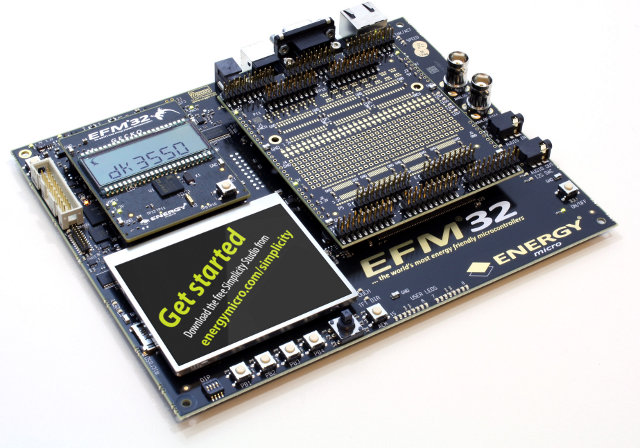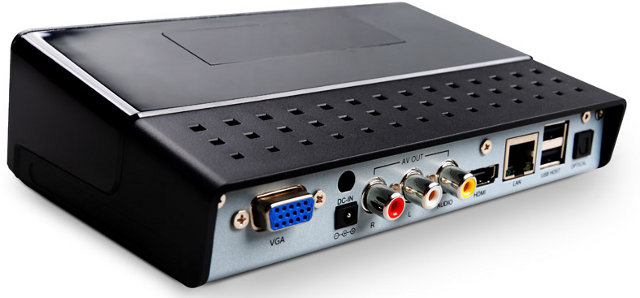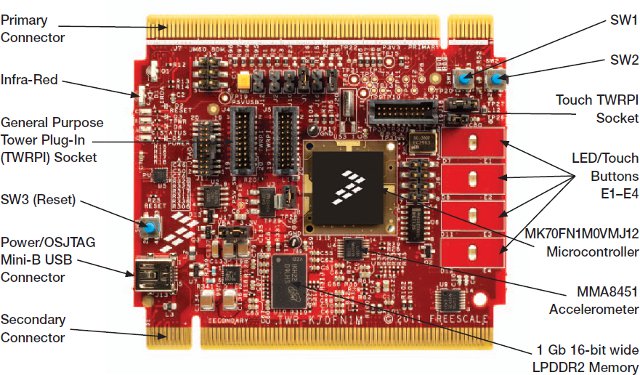In January, Texas Instruments was the first company (to my knowledge) to release a WiFi chip for the internet of things, the SimpleLink Wi-Fi CC3000, where WiFi is mostly implemented in hardware to lower power consumption. Now, the company has some competition with the announcement of Qualcomm Atheros AR4100P, an improved version of its AP4100 WiFi chipset, including IPv4/IPv6 support. The AR4100 targets the home, enterprise, smart grid and home automation and control applications that have lower data rates and transmit or receive data on an infrequent basis. The AR4100 system-in-package (SIP) features the following: Low energy Power saving modes as low as 5 µA Wake-up times as low as 2.2 ms Support for Quad SPI flash for faster wake times Low system resource requirements Low footprint host driver (25K Flash and 8K RAM) Simple, low-cost wireless system integration LGA package simplifies 2- or 4-layer PCB design Near zero RBOM […]
Energy Micro Announces EFM32G-DK3550 Gecko (Cortex-M3) Development Kit
Energy Micro has just announced the availability of the EFM32G-DK3550 development kit based on ARM Cortex-M3 EFM32G890F128 MCU. The kit (pictured below) is based on the main board from the bigger Leopard and Giant Gecko kits and supports SEGGER J-Trace and J-Link in order to reduce the need for additional debugging tools. Here are the development kit specifications: EFM32G890F128 Gecko Cortex-M3 MCU 4MB PSRAM 16MB NOR-Flash 320 x 240 RGB resistive touch TFT display Ethernet MAC/PHY microSD slot audio I/O and I2S DAC USB debug interface, SEGGER J-Link debugger Advanced Energy Monitoring (AEM) system to monitor the prototype’s energy consumption. 2x RS232, IrDA Switches, Joystick, LEDs, potentiometer… EXP32 Prototyping area (right side of the picture) For software development, Energy Micro provides Simplicity Studio suite, which includes energyAware Profiler that can interface with the AEM system via USB, gather all relevant system data, and display real-time graphs of current consumption on a […]
Intel Announces Atom CE5300 Media Processor for STBs and Smart TVs
Intel announced the Atom CE5300 Media Processor (codenamed Berryville) to be used in set-top boxes and smart TVs at IPTV World Forum. This new processor is the replacement for CE4100, CE4130 and CE4150 media processors used in the D-Link Boxee Box and Sony NSX-24GT1 Google TV. The Intel Atom CE5300 Media Processor is manufactured using 32nm part and features a dual Intel Atom core with support for hyper-threading and virtualization, an advanced 3D/2D graphics engine, integrated power management, and an H.264 B-picture hardware encoder. That’s all we know for now, as Intel did not provide further information such as a product brief for their new SoC. The Amino Freedom Live Media Gateway, an Hybrid/OTT media gateway powered by the Intel Atom CE5300, is currently showcased at IPTV World Forum. This STB also features the latest Opera TV Browser that support HTML5, JavaScript and WebGL technology among other things. Jean-Luc Aufranc […]
Mele A1000: AllWinner A10 (Cortex A8) Based Hackable Android STB
The Mele A1000 is an Android 2.3 IP Set-top Box (STB) powered by AllWinner A10 (Cortex A8) CPU with 512 MB RAM and 2 GB NAND Flash. AllWinner A10 is the CPU to be used by the 15 USD (BOM Cost) Rhombus Tech Linux Computer, an alternative to the Raspberry-Pi. Since they do not have an alpha board yet, the Mele A1000 STB is apparently the development platform chosen by developers involved in Rhombus Tech low cost board while they wait for the hardware. Let’s have a look at the device specifications: CPU: ARM CortexA8 1GHz (AllWinner A10) Memory: DDR3 512MB RAM / 2 4GB Nand Flash OS System: Android 2.3 External Storage: Supports SD card up to 32GB, supports 2.5″ SATA HDD up to 1TB, Supports max 16GB USB flash disk Video coding: HD MPEG1/2/4.H.264.HD AVC/VC-1,RM/RMVB, Xvid/DviX4/5/6, RealVideo8/9/10, VP6 Video Format: ts/m2ts/tp/trp/mkv/mp4/mov/avi/rm/rmvb/wmv/vob/asf/flv/dat/mpf/mpeg Audio Format: MP3/WMA/WMV/OGG/FLAC/MKV Subtitle Format: SRT/SMI/SSA/ASS Network […]
uClinux Running on Freescale Kinetis K70 MCU (Cortex-M4) Module
Last year, I posted about Linux for Cortex M3 & M4 Micro-controllers and noted it was difficult to find cost effective Cortex-M based boards able to run uClinux or Linux (RAM being the main issue). Freescale TWR-K70F120M is a module based on Kinetis K70 MCU (Cortex M-4) with plenty of RAM (128MB) to run Linux or uClinux. It is available for 109 USD or 179 USD with Freescale Tower system (TWR-K70F120M-KIT). Here are the key features of the module: Freescale MK70FN1M0VMJ12 Cortex-M4 MCU @ 120 MHz (Product Brief) Touch Tower Plug-in Socket General purpose Tower Plug-in (TWRPI) socket On-board JTAG debug circuit (OSJTAG) with virtual serial port 128 MB DDR2 SDRAM memory 256 MB SLC NAND flash memory Three axis accelerometer (MMA8451Q) Potentiometer Micro-SD Card slot I could not find an open source uClinux implementation for Kinetis K70, but emCraft has a Linux Board Support Package (BSP) for the Freescale TWR-K70F120M-KIT […]
Archos G10 xs Teaser Video with Sliding Keyboard Dock
Archos has just released a teaser video for its next generation Android tablet, the Archos G10 xs (xs stands for extra small). The video does not show much, except the concept of the new tablet which features a sliding keyboard where the tablet can be docked. Archos has not released the specifications for the G10 XS yet, but we do know the casing is made of stainless steel, is 7.6mm thick (12mm with the keyboard) and Archos has worked for 3 years on this design. There will be several models whose retail price should be between 200 and 300 Euros (Which would be between 200 and 300 USD in the US thanks to lower taxes). The new tablets will be powered by a Texas Instruments processor (probably OMAP 4) like the Archos G9 tablets and run Android 4.0 and Windows 8 depending on the model. Jean-Luc Aufranc (CNXSoft)Jean-Luc started CNX […]
Using Android Outside the Mobile Phone Space – Android Builder Summit 2012
Jason Kridner, chief software architect for the Sitara ARM microprocessor business at Texas Instruments (TI) and the community development manager, explains why and how to use Android in diverse embedded systems (and not only smartphones and tablets) at the Android Builder Summit in February 2012. Abstract: A few years back all embedded devices were designed like PCs. For example, users understood the use of a mouse and keyboard and could minimize and maximize a window using mouse clicks and launch new applications from Start. The increasing demand and usage of smartphones globally has not just changed the definition of user experience for embedded equipments but has made emerging technologies like touch and display panels, connectivity solutions and infrastructure, affordable to non- phone products segments. The embedded equipment designers and users have grown accustomed in no time to the smartphone features and technologies like multi-touch, high-resolution display panels, connectivity over 3G […]
The AllJoyn Open Source Project – Android Builder Summit 2012
Marcello Lioy, Director engineering at Qualcomm Innovation Center, talks about AllJoyn open source project at then Android Builder Summit in February 2012: Description of AllJoyn project: AllJoyn is a peer-to-peer technology that enables ad hoc, proximity-based, device-to-device communication without the use of an intermediary server. True peer-to-peer communications without the traditional barriers Simple device and service discovery Security framework for authenticated and encrypted communications per application/service Managed networking and message routing Object-oriented programming model Optimized for the mobile embedded environment Low latency Header compression Reliable and unreliable transport Point-to-multipoint communications Potential applications of the technology include Multi-player gaming Social media sharing Multi-user productivity tools AllJoyn is part of Qualcomm Android development tools. I could not find the presentation slides for this particular talk. Jean-Luc Aufranc (CNXSoft)Jean-Luc started CNX Software in 2010 as a part-time endeavor, before quitting his job as a software engineering manager, and starting to write daily news, and […]








